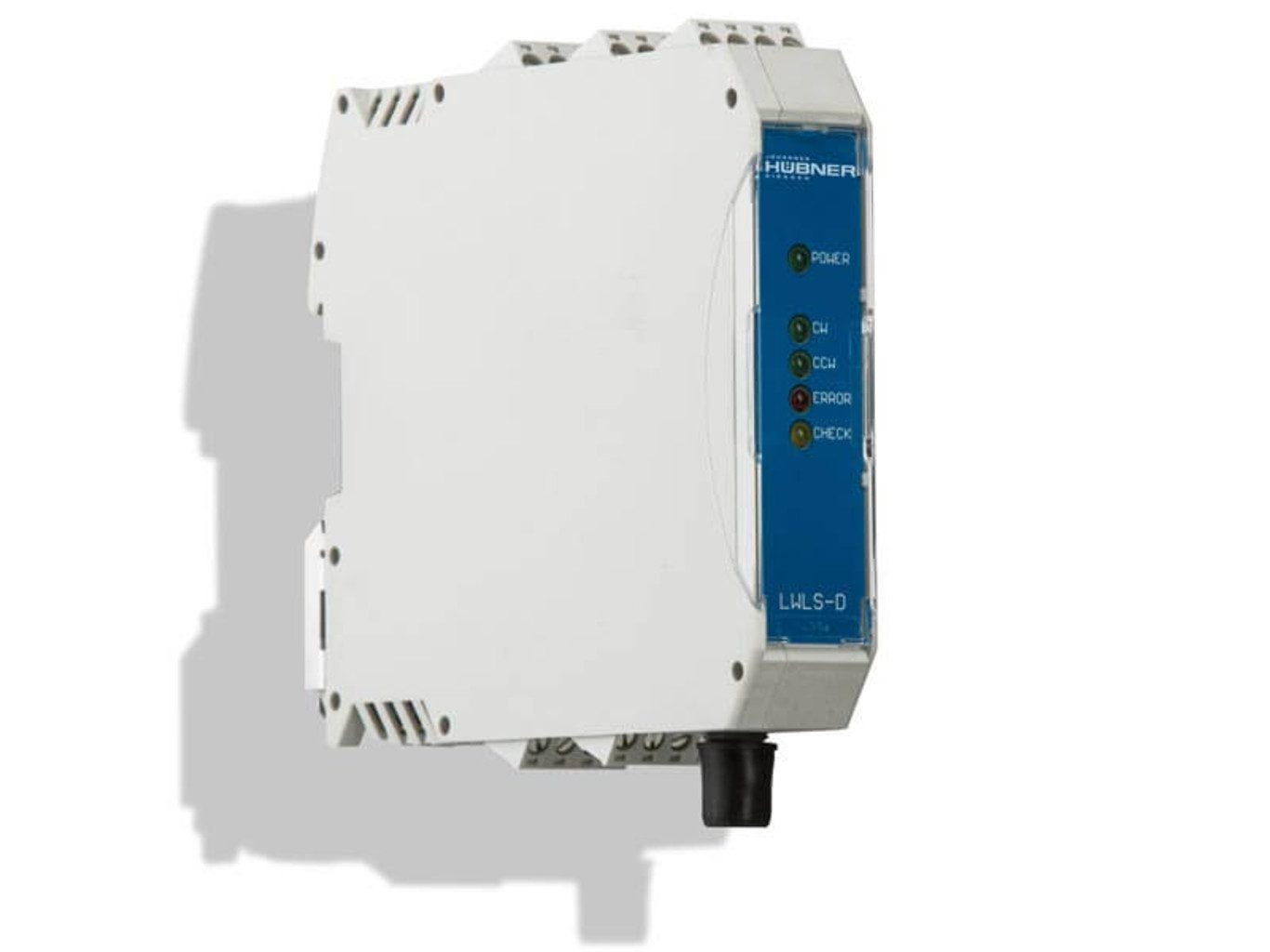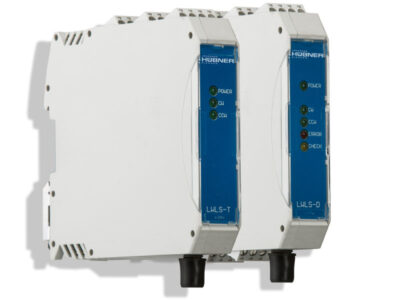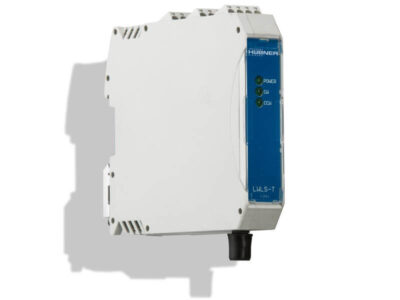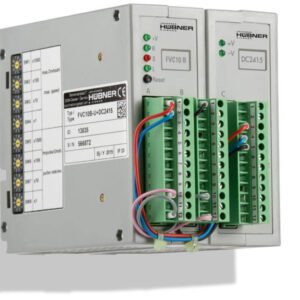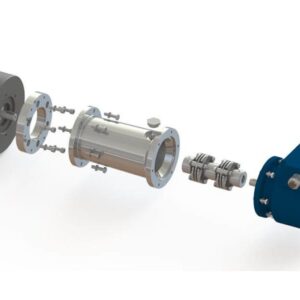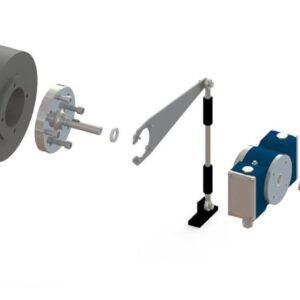Description
LWLS-T / LWLS-D(i)
FOC transmitter / decoder set – HTL/TTL (up to 100 kHz)
- Module set (transmitter + decoder) for incremental signals (HTL or TTL)
- Alternative: Combination of decoder module and encoder with integrated transmitter
- Disturbance-free signal transmission up to 1000 m range; signal conversion time 2 µs
- Options: FOC break monitoring, galvanically isolated output blocks, aluminium die-cast housing for outdoor applications (IP66)
FOC transmitter / decoder set for incremental signals
FOC transmitters and FOC decoders are always installed when electric incremental signals are to be transmitted disturbance-free via fiber optic cables. They encode and transmit signals via a fiber optic cable to the decoder in the switchboard, where they can be used by the controller or other modules in the switchboard. In doing so they ensure high data transmission rates even over long cable lengths. Electrical isolation guarantees high levels of transmission reliability. It is possible to select HTL and/or TTL as input blocks. Optional FOC cable break monitoring is available to increase system reliability. Many Hübner Giessen encoder solutions are optionally also available with an integrated FOC transmitter.
Technical Data
| Product usage | Implement FOC transmission path (Incremental) |
| Supply voltage | 12-30 VDC |
| Signal input | Transmitter LWLS-T (switchboard) uad LWL-T (housing for outdoor applications) Signal input (from encoder):
Signal transmission (outputs transmitter module):
Signal level:
|
| Signal output | Decoder LWLS-D and LWLS-Di (galvanically isolated output blocks) Signal output (to controller):
Signal transmission (inputs decoder module):
Signal level:
|
| Frequency range | 0 – 100 kHz |
| Casing | Transmitter
Decoder
|
| Dimensions | Transmitter
Decoder
|
| Device temperature range | Transmitter
Decoder
|
| Degree of protection | Transmitter
Decoder
|
| Electrical connection | Transmitter
Decoder
|
| Device options |
|
| Mechanical options | Aluminium die-cast housing for outdoor applications (Transmitter) |
| Special features and certificates | New transmission technology – patent pending |
Downloads
More About The LWLS-T / LWLS-D(i) Transmitter Decoder Set Offered In Australia
The LWLS-T / LWLS-D(i) Transmitter Decoder Set is a module set that includes both a transmitter and decoder for incremental signals (HTL or TTL). The set allows for fast and highly accurate transmission of encoder signals up to 100 kHz and is interference-free. The LWLS-T transmitter is a FOC (fibre optic cable) transmitter, while the LWLS-D(i) decoder is an electronic module that decodes the transmitted signal.
Some additional information about the LWLS-T / LWLS-D(i) Transmitter Decoder Set offered by Hubner Australia can be found on their website. The set is also available through other companies such as Johannes Hübner Giessen and Flohr Industrietechnik.
Other features of the set include:
- The transmitter and decoder can be combined with an encoder that has an integrated transmitter.
- The LWLS-T transmitter is compatible with fibre optic cables.
- The LWLS-D(i) decoder has a compact design that makes it easy to install.
What is the difference between LWLS-T and LWLS-D(i) Transmitter Decoder Set?
The LWLS-T / LWLS-D(i) Transmitter Decoder Set is a module set that includes both a transmitter and decoder for incremental signals (HTL or TTL). The LWLS-T transmitter is an FOC (fibre optic cable) transmitter, while the LWLS-D(i) decoder is an electronic module that decodes the transmitted signal. Both of them are used for interference-free signal transmission over long distances.
The main difference between the LWLS-T and LWLS-D(i) is that the LWLS-T is a transmitter, while the LWLS-D(i) is a decoder. The LWLS-T transmitter converts the electric incremental encoder signals into optical signals and sends them via a fibre optic cable to the LWLS-D(i) decoder in the switchboard.
The LWLS-D(i) decoder receives the optical signal and decodes it into an electric signal, which can be used by the controller or other modules. Additionally, the LWLS-D(i) decoder has galvanically isolated output blocks and is available in an electronic housing for standard mounting rails.
Both the LWLS-T transmitter and LWLS-D(i) decoder are part of the FOC transmitter/decoder set for incremental signals offered by Johannes Hübner Giessen, which is also available through other companies such as Hubner Australia.
What are the applications of the LWLS-T / LWLS-D(i) Transmitter Decoder Set?
The LWLS-T / LWLS-D(i) Transmitter Decoder Set is used for interference-free signal transmission over long distances. The applications of the LWLS-T / LWLS-D(i) Transmitter Decoder Set include:
- Transmitting electric incremental signals disturbance-free via fibre optic cables.
- Encoding and transmitting signals via a fibre optic cable to the decoder in the switchboard, where they can be used by the controller or other modules.
- Converting electrical incremental encoder signals into fibre optics signals.
- Transmitting signals over long distances without interference.
The LWLS-T / LWLS-D(i) Transmitter Decoder Set is designed for use with incremental signals (HTL or TTL) and can be used with a combination of a decoder module and encoder with an integrated transmitter.
The LWLS-T transmitter is available in an electronic housing for standard mounting rails or a die-cast metal aluminium housing for outdoor applications. The LWLS-D(i) decoder is available in an electronic housing for standard mounting rails and has galvanically isolated output blocks.
Are there any other products offered by Hubner Australia for signal transmission?
Yes, there are other products offered by Hubner Australia for signal transmission. Some of the products offered by Hubner Australia for signal transmission include:
- FOC signal transmission for HTL/TTL (up to 100 kHz).
- Finger protection profile with LED illumination.
Additionally, Johannes Hübner Giessen, the parent company of Hubner Australia, offers other products for signal transmission, such as FOC transmitter LWL(S)-T / FOC decoder LWLS-D(i). Hubner Group has numerous trade representatives around the world who make it possible for smooth and uninterrupted exchanges to take place with customers and businesses.


